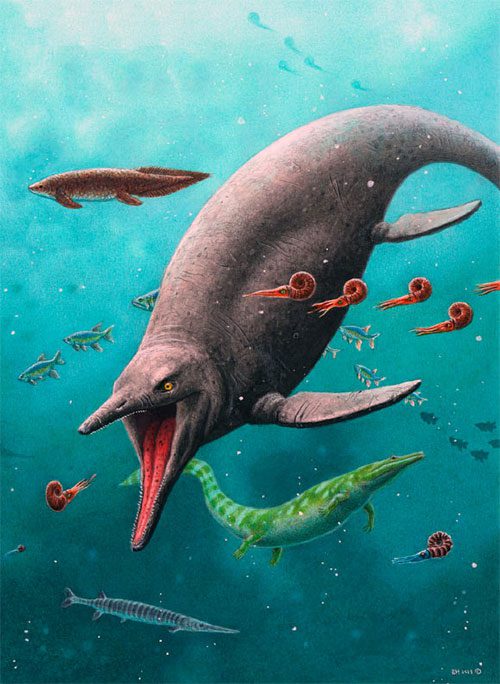The discovery of ichthyosaurs in the Vikinghøgda Formation on Spitsbergen Island in the Arctic will have significant implications for paleontology and zoological curricula. We will need to revise our previous understanding of species that existed in harsh environments and gain a deeper insight into the biodiversity on our planet.
According to Sci-News, a paleontological research team from Uppsala University (Sweden) and the University of Oslo (Norway) studied well-preserved vertebrae of an ichthyosaur, which translates to “fish lizard” or “ichthyosaur”, dating back only 2 million years after the end-Permian mass extinction event.
The end-Permian mass extinction occurred 252 million years ago, devastating marine ecosystems and paving the way for what is known as the “Age of Dinosaurs”, during which the earliest dinosaurs emerged several tens of millions of years later in the Triassic period.

Graphic depiction of ancient ichthyosaurs – (Image: Esther van Hulsen).
However, the 250-million-year-old ichthyosaur fossil discovered by scientists reveals a creature that has fully evolved characteristics of its lineage, with a streamlined body, relatively small head, elongated snout, flipper-like limbs, and a tail resembling that of a dolphin.
Paleontologist Benjamin Kear from Uppsala University stated, “According to textbooks, terrestrial reptiles with walking limbs invaded coastal shallow environments to exploit ecological niches left behind by marine predators after the catastrophic event. Over time, these initial amphibious reptiles became more efficient swimmers and eventually transformed their limbs into flippers, developing fish-like body shapes.”
To align with this “textbook” hypothesis, ichthyosaurs would need to have emerged long after the end-Permian extinction event. If a 250-million-year-old ancestral ichthyosaur were discovered, it would have to exhibit primarily terrestrial reptilian features and live an amphibious lifestyle, as 2 million years is too short for a complete transformation.
However, the specimen from Spitsbergen is a perfect ichthyosaur, leading researchers to conclude that this lineage of marine monsters began evolving long before the mass extinction and managed to survive the event.
“The vertebrae are identical to those of larger and much younger ichthyosaurs, even preserving microstructural features in the bones that indicate signs of rapid development, high metabolism, and a fully marine lifestyle,” Dr. Kear added.
Geochemical analysis of the environment surrounding the fossil site has confirmed the age of the fossil and forced paleontologists to revise textbooks related to ichthyosaurs.
This discovery also profoundly impacts the developmental model of the Age of Dinosaurs in general, indicating that the aquatic version of dinosaurs has ancient origins at least tens of millions of years earlier than previously thought. The origins of ichthyosaurs will also need to be recalculated.
Scientists still hope to one day find even older ichthyosaur specimens—such as one from the Permian period—to further understand this marine monster that thrived until the Chicxulub asteroid impact 66 million years ago, which led to the extinction of the dinosaurs.
This research was recently published in the scientific journal Current Biology.


















































